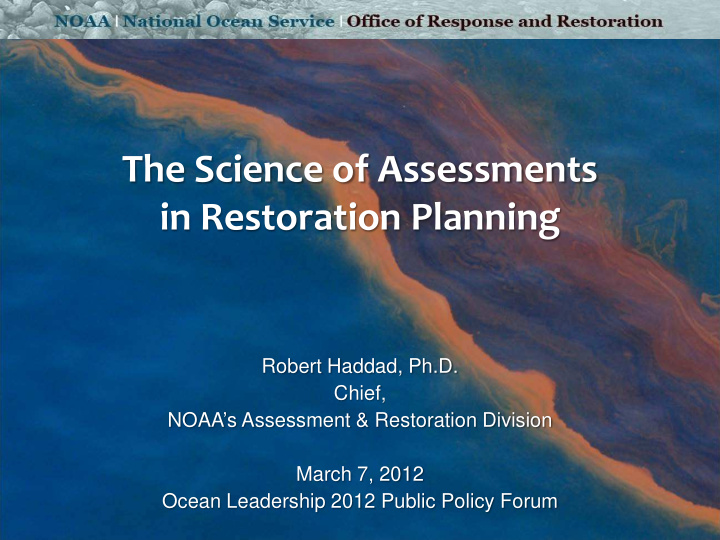



The Science of Assessments in Restoration Planning Robert Haddad, Ph.D. Chief, NOAA’s Assessment & Restoration Division March 7, 2012 Ocean Leadership 2012 Public Policy Forum
A Good Assessment is the Key to A Good Restoration
Oil Pollution Act NRDA Framework PREASSESSMENT SCREEN Ephemeral Data Collection Activities Release Public and Community Involvement RESTORATION PLANNING Injury Assessment Restoration Selection Pathway Restoration Scoping Field Studies Project Identification Data Evaluation Project Scaling Exposure Modeling Draft Restoration Plan Injury Quantification Final Restoration Plan Injury RESTORATION IMPLEMENTATION 3
Future of Assessment Science By virtue of the legal authorities we work under, NRD assessment science is applied science For active research, we look to partnerships with academic and other NGO communities Moving forward, assessments must take advantage of: Techniques that are more synoptic Techniques that provide rapid/real time information Techniques that are more ecologically relevant
Mathematical Models
Satellites and high resolution aerial photography provide a synoptic view for impacts with large geographically footprints
ROVs, AUVs, Submarines All provide invaluable scientific information Holographic Camera and Video New ROVs, AUVs, with Camera with Visible & UV Lights, more sensors LISST for oil droplets White Light Black Light
From the old to the new - more sensitive methods for collecting and analyzing contaminants
Telemetry Sei Whale – Mar-July 2011 Tuna - http://www.topp.org/blog/hot_tuna _and_oil_bluefin_gulf_mexico Juvenile Green Turtles Provides real time information on exposure of resources to 11 the contaminants
Moving To Injury Cosco Busan Herring High mortality in intertidal spawn (exposed at low tide)
Microarrays and oil-induced heart failure in fish embryos 3 mm Environ. Toxicol. Chem. 29, 2010 Anatomy is slow and labor-intensive, gene fingerprinting is rapid and cheap
Tursiops Nearshore Assessment: Multi-pronged Approach Stranding response & active surveillance Longitudinal small vessel based surveys 4 BSE sites Capture-release health assessment 2 sites (exposed/unexposed) Focused prey sampling
Toxicity Primary Objectives of Test Program Evaluate toxicological responses of representative Gulf of Mexico aquatic biota to Deepwater Horizon oil and dispersant. Toxicants Exposure Receptors Responses - Oil - Dissolved - Finfish - Survival - Dispersant - Droplets - Invertebrates - Reproduction - Floating oil - Growth - Diet - Behavior - Disease - Physiology
Data Input Data Management Data Analysis and Visualization
Heading Towards Restoration, What is needed? Better models that guide our understanding of ecosystem- level needs Better tools with focus on both enhanced exposure and on causality Better ways to manage, analyze, and visualize the large amounts of data that are the staple of most environmental projects Continued strong integration between injury and restoration
Questions? Robert Haddad NOAA robert.haddad@noaa.gov response.restoration.noaa.gov
Recommend
More recommend